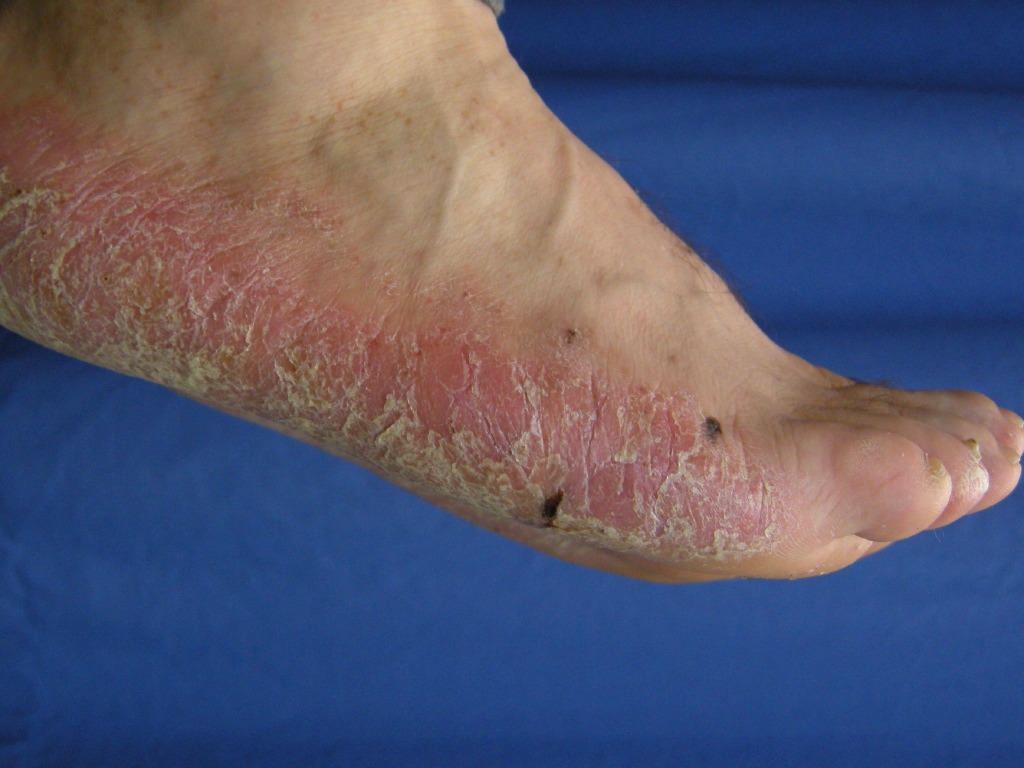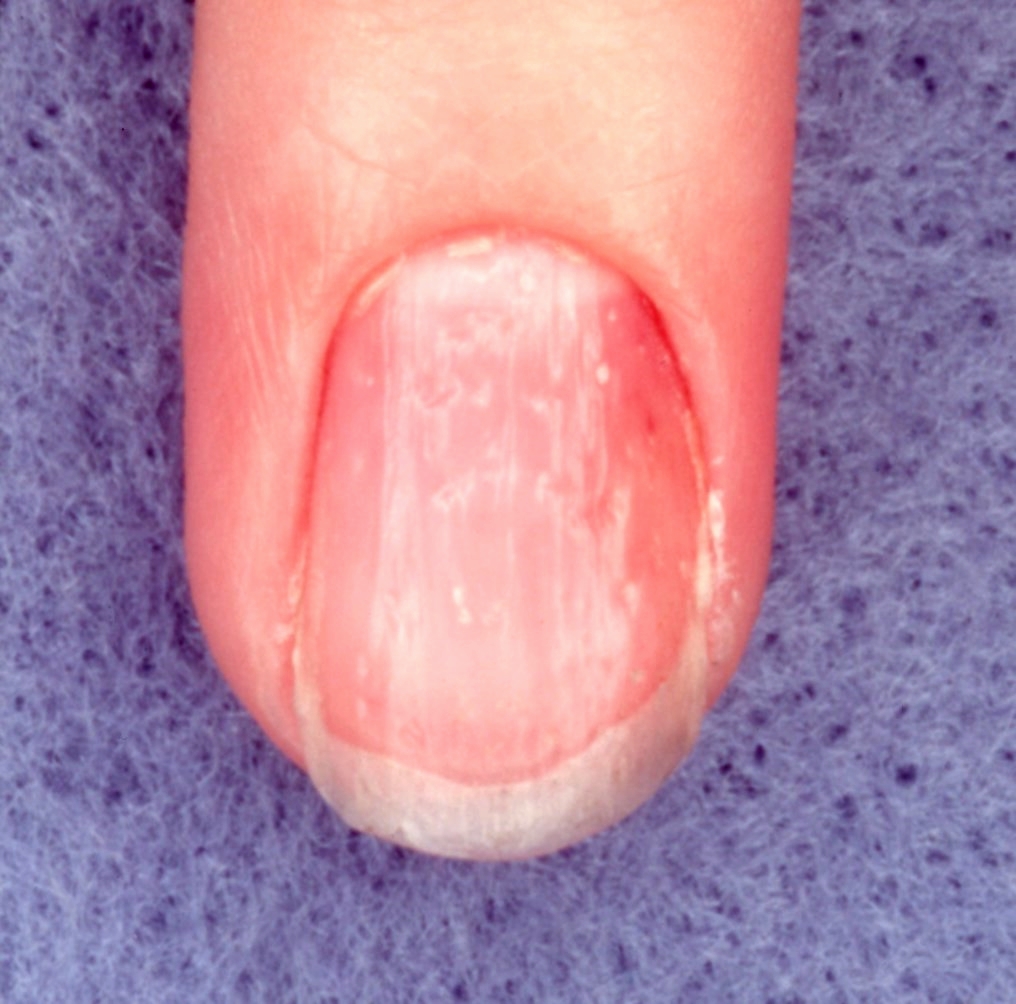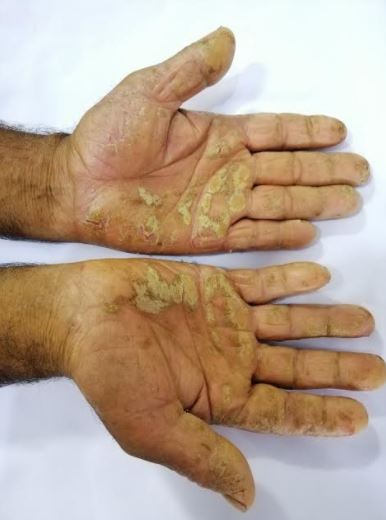[1]
Farley E, Masrour S, McKey J, Menter A. Palmoplantar psoriasis: a phenotypical and clinical review with introduction of a new quality-of-life assessment tool. Journal of the American Academy of Dermatology. 2009 Jun:60(6):1024-31. doi: 10.1016/j.jaad.2008.11.910. Epub
[PubMed PMID: 19467374]
Level 2 (mid-level) evidence
[2]
Asumalahti K, Ameen M, Suomela S, Hagforsen E, Michaëlsson G, Evans J, Munro M, Veal C, Allen M, Leman J, David Burden A, Kirby B, Connolly M, Griffiths CE, Trembath RC, Kere J, Saarialho-Kere U, Barker JN. Genetic analysis of PSORS1 distinguishes guttate psoriasis and palmoplantar pustulosis. The Journal of investigative dermatology. 2003 Apr:120(4):627-32
[PubMed PMID: 12648227]
[3]
Kingo K, Mössner R, Kõks S, Rätsep R, Krüger U, Vasar E, Reich K, Silm H. Association analysis of IL19, IL20 and IL24 genes in palmoplantar pustulosis. The British journal of dermatology. 2007 Apr:156(4):646-52
[PubMed PMID: 17263806]
[4]
Coto-Segura P,González-Fernández D,Batalla A,Gómez J,González-Lara L,Queiro R,Alonso B,Iglesias S,Coto E, Common and rare CARD14 gene variants affect the antitumour necrosis factor response among patients with psoriasis. The British journal of dermatology. 2016 Jul;
[PubMed PMID: 26854129]
[5]
Khandpur S, Singhal V, Sharma VK. Palmoplantar involvement in psoriasis: a clinical study. Indian journal of dermatology, venereology and leprology. 2011 Sep-Oct:77(5):625. doi: 10.4103/0378-6323.84071. Epub
[PubMed PMID: 21860174]
[6]
Murakami M, Hagforsen E, Morhenn V, Ishida-Yamamoto A, Iizuka H. Patients with palmoplantar pustulosis have increased IL-17 and IL-22 levels both in the lesion and serum. Experimental dermatology. 2011 Oct:20(10):845-7. doi: 10.1111/j.1600-0625.2011.01325.x. Epub 2011 Jul 7
[PubMed PMID: 21732985]
[7]
Chopra A, Maninder, Gill SS. Hyperkeratosis of palms and soles : clinical study. Indian journal of dermatology, venereology and leprology. 1997 Mar-Apr:63(2):85-8
[PubMed PMID: 20944281]
[8]
Kumar B,Saraswat A,Kaur I, Palmoplantar lesions in psoriasis: a study of 3065 patients. Acta dermato-venereologica. 2002;
[PubMed PMID: 12353710]
[9]
Chung J, Callis Duffin K, Takeshita J, Shin DB, Krueger GG, Robertson AD, Troxel AB, Van Voorhees AS, Edson-Heredia E, Gelfand JM. Palmoplantar psoriasis is associated with greater impairment of health-related quality of life compared with moderate to severe plaque psoriasis. Journal of the American Academy of Dermatology. 2014 Oct:71(4):623-32. doi: 10.1016/j.jaad.2014.04.063. Epub 2014 Jun 2
[PubMed PMID: 24894455]
Level 2 (mid-level) evidence
[10]
Spuls PI, Hadi S, Rivera L, Lebwohl M. Retrospective analysis of the treatment of psoriasis of the palms and soles. The Journal of dermatological treatment. 2003:14 Suppl 2():21-5
[PubMed PMID: 14578095]
Level 2 (mid-level) evidence
[11]
Janagond AB, Kanwar AJ, Handa S. Efficacy and safety of systemic methotrexate vs. acitretin in psoriasis patients with significant palmoplantar involvement: a prospective, randomized study. Journal of the European Academy of Dermatology and Venereology : JEADV. 2013 Mar:27(3):e384-9. doi: 10.1111/jdv.12004. Epub 2012 Oct 16
[PubMed PMID: 23066720]
Level 1 (high-level) evidence
[12]
Sanchez IM,Sorenson E,Levin E,Liao W, The Efficacy of Biologic Therapy for the Management of Palmoplantar Psoriasis and Palmoplantar Pustulosis: A Systematic Review. Dermatology and therapy. 2017 Dec;
[PubMed PMID: 29143230]
Level 1 (high-level) evidence
[13]
Bissonnette R, Poulin Y, Guenther L, Lynde CW, Bolduc C, Nigen S. Treatment of palmoplantar psoriasis with infliximab: a randomized, double-blind placebo-controlled study. Journal of the European Academy of Dermatology and Venereology : JEADV. 2011 Dec:25(12):1402-8. doi: 10.1111/j.1468-3083.2011.03984.x. Epub 2011 Feb 23
[PubMed PMID: 21349113]
Level 1 (high-level) evidence
[14]
Richetta AG, Mattozzi C, Giancristoforo S, D'Epiro S, Cantisani C, Macaluso L, Salvi M, Calvieri S. Safety and efficacy of Adalimumab in the treatment of moderate to severe palmo-plantar psoriasis: an open label study. La Clinica terapeutica. 2012:163(2):e61-6
[PubMed PMID: 22555836]
[15]
Au SC, Goldminz AM, Kim N, Dumont N, Michelon M, Volf E, Hession M, Lizzul PF, Andrews ID, Kerensky T, Wang A, Yaniv S, Gottlieb AB. Investigator-initiated, open-label trial of ustekinumab for the treatment of moderate-to-severe palmoplantar psoriasis. The Journal of dermatological treatment. 2013 Jun:24(3):179-87. doi: 10.3109/09546634.2012.672710. Epub 2012 May 8
[PubMed PMID: 22390688]
[16]
Gottlieb A, Sullivan J, van Doorn M, Kubanov A, You R, Parneix A, Hugot S, Milutinovic M. Secukinumab shows significant efficacy in palmoplantar psoriasis: Results from GESTURE, a randomized controlled trial. Journal of the American Academy of Dermatology. 2017 Jan:76(1):70-80. doi: 10.1016/j.jaad.2016.07.058. Epub 2016 Oct 1
[PubMed PMID: 27707593]
Level 1 (high-level) evidence
[17]
Menter A, Warren RB, Langley RG, Merola JF, Kerr LN, Dennehy EB, Shrom D, Amato D, Okubo Y, Reich K. Efficacy of ixekizumab compared to etanercept and placebo in patients with moderate-to-severe plaque psoriasis and non-pustular palmoplantar involvement: results from three phase 3 trials (UNCOVER-1, UNCOVER-2 and UNCOVER-3). Journal of the European Academy of Dermatology and Venereology : JEADV. 2017 Oct:31(10):1686-1692. doi: 10.1111/jdv.14237. Epub 2017 Apr 26
[PubMed PMID: 28322474]



